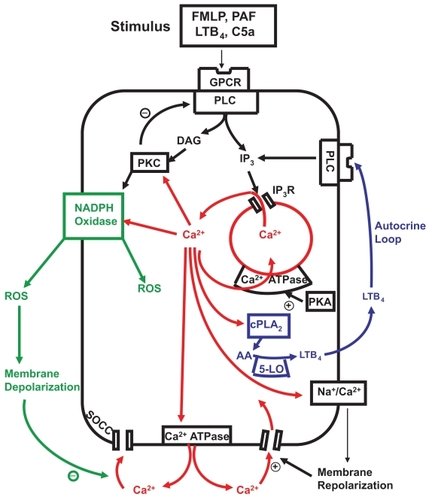Figures & data
Figure 1 Activation of neutrophils by chemoattractants such as FMLP, PAF, C5a, and LTB4 increases cytosolic Ca2+ concentrations with resultant generation of toxic reactive oxygen species (ROS) and release of proteases, matrix metalloproteinases (MMPs) and lipid mediators. The tissue injury that may be associated with release of these harmful molecules into the vicinity of innocent bystander host tissues contributes to the pathogenesis of numerous diseases, including chronic obstructive pulmonary disease (COPD) and the acute respiratory distress syndrome (ARDS).

Figure 2 Calcium-mobilizing stimuli interact with membrane G-protein coupled receptors (GPCR) to activate phospholipase C (PLC) generating inositol triphosphate (IP3) which interacts with IP3 receptors (IP3R) releasing Ca2+ from storage vesicles. Cytosolic Ca2+ phospholipase A2 (cPLA2) Which mobilizes arachidonic acid (AA) for the 5-lipoxygenase (5-LO) pathway. The AA metabolite leukotriene B4 (LTB4) is actively transported to the cell exterior where it binds to its receptor to activate PLC, completing a positive feedback autocrine loop. Ca2+ released into the cytosol is rapidly extruded from the cell by the plasma membrane Ca2+ ATPase and resequested into storage vesicles by the protein kinase A (PKA)-sensitive endomembrane Ca2+ ATPase. Protein kinase C (PKC) activated by Ca2+ and diacylglycerol (DAG) facilitates assembly and activation of NADPH oxidase on the outer membrane which generates reactive oxygen species (ROS) with concomitant membrane depolarization. The depolarized membrane potential delays Ca2+ entry through store operated channels (SOCCs) until the Ca2+-activatible Na+/Ca2+ exchanger, operating in reverse mode, mediates recovery of the membrane potential promoting Ca2+ reuptake via SOCCs. PKC down-regulates PLC as part of a negative feedback loop to terminate IP3 production
